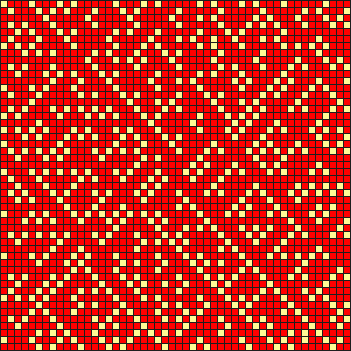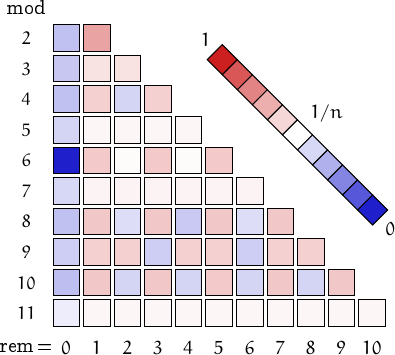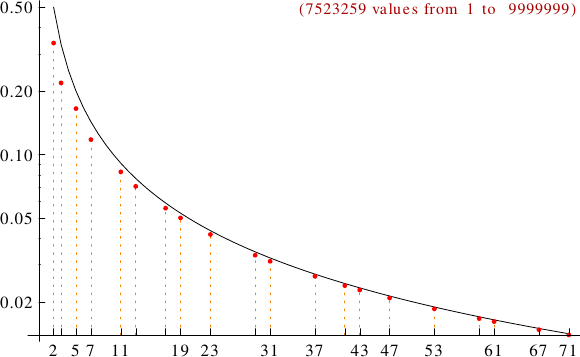A number  is said to be deficient if
is said to be deficient if  , i.e., if the sum of the proper divisors of
, i.e., if the sum of the proper divisors of  is smaller than
is smaller than  .
.

For example, 7 is deficient, since its only proper divisor is 1, which is smaller than 7. It is easy to see that all the primes, their powers and all the semiprimes apart 6, are deficient.
Moreover, if a number is perfect or deficient, then all its proper divisors are deficient.
J.Sándor has proved that for sufficiently large there is always
a deficient number between
and
.
About 3/4 of the integers are deficient. The first deficient numbers are 1, 2, 3, 4, 5, 7, 8, 9, 10, 11, 13, 14, 15, 16, 17, 19, 21, 22 more terms
Below, the spiral pattern of deficient numbers up to 2500. See the page on prime numbers for an explanation and links to similar pictures.
Pictorial representation of remainders (mod 2, 3, ...,11) frequency. For a table of values and more details click here

A graph displaying how many deficient numbers are multiples of the primes p from 2 to 71. In black the ideal line 1/p.

Deficient numbers can also be... (you may click on names or numbers and on + to get more values)
a-pointer
11
13
101
+
9999347
ABA
32
50
64
+
9981512
aban
10
11
13
+
9000999
Achilles
675
1125
1323
+
9981512
alt.fact.
19
101
619
+
3301819
alternating
10
14
16
+
9898989
amenable
13
16
17
+
9999997
amicable
284
1210
2924
+
9892936
anti-perfect
244
285
133857
apocalyptic
157
218
226
+
29999
arithmetic
11
13
14
+
9999999
astonishing
15
27
429
+
7103835
automorphic
25
76
376
+
2890625
balanced p.
53
157
173
+
9999937
Bell
15
52
203
+
4213597
bemirp
1061
1091
1601
+
1909081
betrothed
75
195
1648
+
9345903
binomial
10
15
21
+
9992685
brilliant
10
14
15
+
9999811
c.decagonal
11
31
61
+
9989911
c.heptagonal
22
43
71
+
9990436
c.nonagonal
10
55
91
+
9983746
c.octagonal
25
49
81
+
9991921
c.pentagonal
16
31
51
+
9995001
c.square
13
25
41
+
9994921
c.triangular
10
19
31
+
9996214
cake
15
26
64
+
9886826
Canada
125
581
8549
16999
Carmichael
561
1105
1729
+
9890881
Carol
47
223
959
+
4190207
Catalan
14
429
4862
Chen
11
13
17
+
9999991
congruent
13
14
15
+
9999999
constructible
10
15
16
+
8913032
cube
27
64
125
+
9938375
Cullen
25
65
161
+
9961473
Cunningham
10
15
17
+
9999999
Curzon
14
21
26
+
9999981
cyclic
11
13
15
+
9999997
D-number
15
21
33
+
7043133
d-powerful
43
63
89
+
9999865
de Polignac
127
149
251
+
9999997
decagonal
10
27
52
+
9993501
deceptive
91
259
451
+
9989161
dig.balanced
10
11
15
+
9999994
double fact.
15
105
Duffinian
16
21
25
+
9999997
eban
32
34
44
+
6066064
economical
10
11
13
+
9999991
emirp
13
17
31
+
9999971
emirpimes
15
26
39
+
9999998
enlightened
250
256
2048
+
5117695
equidigital
10
11
13
+
9999991
eRAP
98
170
1274
+
9960047
esthetic
10
21
23
+
9898989
Eulerian
11
26
57
+
8388584
evil
10
15
17
+
9999999
fibodiv
14
19
47
+
9869390
Fibonacci
13
21
34
+
9227465
Friedman
25
121
125
+
999163
frugal
125
128
243
+
9999803
gapful
105
110
121
+
9999985
Gilda
29
49
110
+
4848955
good prime
11
17
29
+
9993337
happy
10
13
19
+
9999992
Harshad
10
21
27
+
9999950
heptagonal
34
55
81
+
9987004
hex
19
37
61
+
9997351
hexagonal
15
45
91
+
9988215
hoax
22
58
85
+
9999922
Hogben
13
21
31
+
9995083
Honaker
131
263
457
+
9987001
house
32
155
271
+
9716393
hungry
17
74
2003
+
7339199
hyperperfect
21
301
325
+
9699181
iban
10
11
14
+
777777
iccanobiF
13
39
124
+
9679838
idoneal
10
13
15
+
1365
impolite
16
32
64
+
8388608
inconsummate
62
63
65
+
999995
insolite
111
interprime
15
21
26
+
9999982
Jacobsthal
11
21
43
+
2796203
Jordan-Polya
16
32
64
+
8388608
junction
101
103
105
+
9999961
Kaprekar
45
55
99
+
9999999
katadrome
10
21
31
+
9876543
Kynea
23
79
287
+
4198399
Lehmer
15
51
85
+
9997351
Leyland
17
32
57
+
9865625
lonely
23
53
211
+
4652429
Lucas
11
29
47
+
7881196
lucky
13
15
21
+
9999997
Lynch-Bell
15
124
128
+
9315
m-pointer
23
61
1123
+
9111341
magic
15
34
65
+
9951391
magnanimous
11
14
16
+
9959374
metadrome
13
14
15
+
3456789
modest
13
19
23
+
9999999
Moran
21
27
45
+
9999950
Motzkin
21
51
127
+
2356779
narcissistic
153
370
371
+
9926315
nialpdrome
10
11
21
+
9999999
nonagonal
46
75
111
+
9992125
nude
11
15
22
+
9999999
O'Halloran
44
116
oban
10
11
13
+
999
octagonal
21
65
133
+
9988225
odious
11
13
14
+
9999998
Ormiston
1913
1931
18379
+
9994631
palindromic
11
22
33
+
9999999
palprime
11
101
131
+
9989899
pancake
11
16
22
+
9997157
panconsummate
10
11
14
+
3097
pandigital
11
15
19
+
9998163
partition
11
15
22
+
9289091
pentagonal
22
35
51
+
9998795
pernicious
10
11
13
+
9999998
Perrin
10
17
22
+
9141872
Pierpont
13
17
19
+
8503057
plaindrome
11
13
14
+
9999999
Poulet
341
561
645
+
9995671
power
16
25
27
+
9991921
powerful
16
25
27
+
9991921
practical
16
32
64
+
8388608
prime
11
13
17
+
9999991
primeval
13
37
107
+
1234679
pronic
110
182
506
+
9969806
Proth
13
17
25
+
9998337
rare
65
621770
repdigit
11
22
33
+
9999999
repfigit
14
19
47
+
7913837
repunit
13
15
21
+
9995083
Rhonda
5265
5439
12985
+
9892552
Ruth-Aaron
15
16
25
+
9997417
Sastry
183
328
715
+
2066115
self
31
53
64
+
9999998
self-describing
22
4444
224444
444422
semiprime
10
14
15
+
9999998
sliding
11
25
29
+
9868025
Smith
22
27
58
+
9999922
Sophie Germain
11
23
29
+
9999653
sphenic
105
110
130
+
9999994
square
16
25
49
+
9991921
star
13
37
73
+
9992341
straight-line
111
123
135
+
9999999
strobogrammatic
11
69
101
+
9998666
strong prime
11
17
29
+
9999971
subfactorial
44
265
14833
1334961
super Niven
10
50
110
+
1000010
super-d
19
31
69
+
9999981
tau
128
136
152
+
9999992
taxicab
1729
20683
40033
+
9443761
tetrahedral
10
35
165
+
9886435
tetranacci
15
29
401
+
7555935
triangular
10
15
21
+
9992685
tribonacci
13
44
81
+
4700770
trimorphic
25
49
51
+
9999999
truncatable prime
13
17
23
+
9986113
twin
11
13
17
+
9999973
uban
10
11
13
+
9000099
Ulam
11
13
16
+
9999999
undulating
101
121
131
+
9898989
unprimeable
206
322
325
+
9999988
untouchable
52
124
146
+
999970
upside-down
19
37
46
+
9995111
vampire
1395
1435
1827
+
939658
wasteful
22
26
33
+
9999999
weak prime
13
19
23
+
9999991
weakly prime
294001
505447
584141
+
9931447
Wieferich
1093
3279
3511
+
6161805
Woodall
17
23
63
+
9961471
Zeisel
105
1419
1729
+
9773731
Zuckerman
11
15
111
+
9939915
zygodrome
11
22
33
+
9999999